Are you wondering exactly how long a muscle-building dumbbell workout should last? Then you’ve found the right article! Because today, I’ll be explaining how long you should lift dumbbells.
As a general rule, dumbbell workouts should last between 60 to 75 minutes. This duration allows beginner and intermediate level trainees to complete a full-body workout at a training volume that is conducive to muscle growth. A workout longer than 120 minutes is not recommended for the average person.
When I started lifting weights, I was puzzled by the same question. Am I training long enough? Am I training too much?!
That’s why today, I want to share my research and personal experience!
So let’s get stuck in!
How Long Should You Lift Dumbbells To Build Muscle?
The ideal duration for a dumbbell workout is 60 to 75 minutes. But why is this? Do most people work out longer or shorter than this recommendation?
That’s what I’ll cover first.
The Average Weight Lifting Duration.
First, how long should you even be working out for?!
The truth is there is no “one size fits all” answer, and I’ll explain why later.
But if you’re on this post, then you’re probably looking for a benchmark number right?
So here it is.
First of all, I tracked down 5 Reddit and Quora polls (multiple polls increased the sample size for more reliable numbers).
Each of the polls asked a similar question:
- How long is your typical workout?
- Ideal workout duration?
- Length of your workouts?
- How long is your workout?
- How long should a single workout be when lifting weights?
And here are the compiled results for the average workout duration:
| Time Spent Lifting Weights | Percent Of Population |
|---|---|
| <30 Minutes | 2% |
| 30 to 45 Minutes | 9% |
| 45 to 90 Minutes | 49% |
| 90 to 120+ Minutes | 35% |
| As Long As Is Required | 5% |
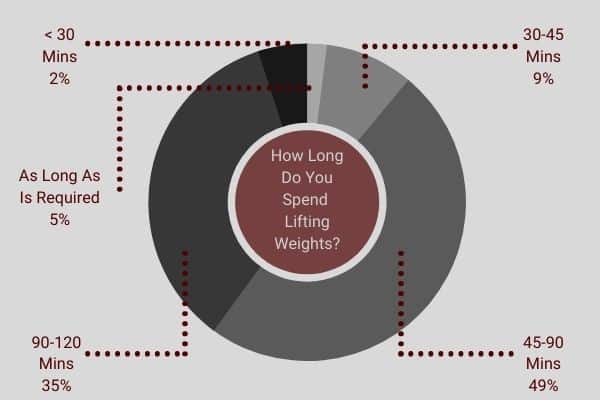
The majority of people (84% to be precise) spend anywhere between 45 minutes to 2 hours per workout lifting weights.
But does that mean you should strictly aim to lift dumbbells for 45 minutes to 2 hours?
Not quite.
45 to 2 hours in itself is a large (and rather unhelpful) time range.
But there’s a more important reason why you shouldn’t limit your dumbbell workouts to specific time frames.
Keep reading to find out why.
Dumbbell Workouts: Long Does Not Equal Effective.
The first thing you need to realize is this- the time you spend lifting dumbbells does not correlate with the benefits gained.
In other words- just because you’re doing a 2-hour workout, doesn’t necessarily mean you will build more muscle than someone who’s doing a 45-minute workout.
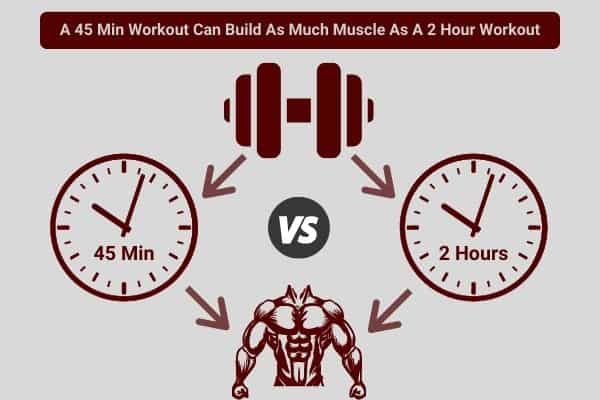
This is because dumbbell training duration is influenced by numerous factors such as:
- Training goal- are you lifting dumbbells to build muscle or doing cardio and other exercises non-beneficial in building muscle?
- Equipment waiting time- are you lifting dumbbells in a busy gym or in a quiet home gym?
- Social distractions- are your dumbbell workouts being prolonged due to chit chat?
- Exercise type- intense dumbbell workouts will last shorter than light dumbbell workouts.
- Warm-up/downs- the duration of your warm-up/warm-downs will affect your total workout duration.
The truth is you can spend 2 hours on a dumbbell workout.
But if half of that time has been wasted talking, waiting for equipment, or doing exercises that don’t help you reach your goal, then you’ll still probably build as much muscle as someone who’s pumped furiously for 45 minutes.
So the point is to concentrate on intense workouts, and not long workouts.
Doing this will increase the efficiency of your dumbbell workouts.
Next, I’ll explain how to capitalize on short and intense dumbbell workouts rather than waste time on long dumbbell workouts.
Find out if home dumbbells are worth the money in my other article!
Aim To Complete Training Volume Not Time-Spent.
Training volume refers to the total amount of work you complete in a week, and increasing training volume is the best driver for muscle growth.
The amount of work you perform is in turn dictated by the number of sets, reps, weight, and training days you perform.
Here’s the ideal training volume for a beginner’s muscle-building dumbbell workout:
| Training Volume | Recommendation For Muscle Growth |
|---|---|
| Number of sets | 12 to 24 sets per muscle group per week. |
| Number of repetitions | 8 to 15 repetitions per set. |
| Amount of weight | 60-80% of 1-rep max for each exercise. |
| Number of training days | 3 to 5 days (training each muscle group a minimum of twice per week). |
The take-home message is to focus on satisfying this training volume, rather than focusing on how long you spend on your dumbbell workout.
If you satisfy your weekly training volume, you will build muscle (assuming you also maintain a bulking diet).
Next, I’ll explain how long each dumbbell workout should take, to satisfy the above training volume.
Check out my other article for nutrition tips to build muscle as a skinny guy!
Recommended Dumbbell Workout Duration To Build Muscle.
Each dumbbell workout should take 60 to 75 minutes to complete, in order to satisfy the training volume mentioned above.
I will now break down the time requirements for a dumbbell workout.
First, let’s assume you use a 3-day full-body dumbbell training split to reach the above training volume. Here’s what this could look like:
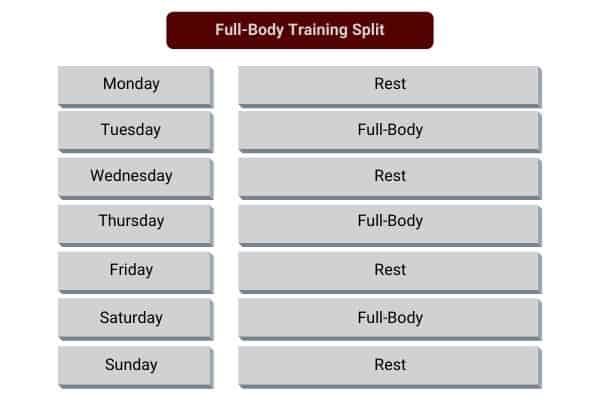
Each full-body dumbbell workout would contain exercises that work each of the 6 major muscle groups (arms, chest, shoulders, back, abs, and legs).
And this is how long each full-body dumbbell workout should take:
| Muscle Group | Sets | Reps | Rest Between Sets | Total time |
|---|---|---|---|---|
| Arms | 4 | 8 to 15 | 2 minutes | 10 to 12 minutes |
| Chest | 4 | 8 to 12 | 2 minutes | 10 to 11 minutes |
| Shoulders | 4 | 8 to 12 | 2 minutes | 10 to 11 minutes |
| Back | 4 | 8 to 12 | 2 minutes | 10 to 11 minutes |
| Abs | 4 | 8 to 15 | 2 minutes | 10 to 12 minutes |
| Legs | 4 | 8 to 12 | 2 minutes | 10 to 11 minutes |
To reach 12 to 24 sets per muscle group per week, you would complete a minimum of 4 sets per exercise (4 sets x 3 training days = 12 sets per muscle group).
This equates to 24 total exercise sets per full-body workout (6 exercises x 4 sets each = 24 total sets).
If each repetition takes approximately 4 seconds to complete, and you’re completing 8 to 15 reps per set, it’ll take you around 12 to 24 minutes to complete all 24 sets (24 sets x 8 or 15 reps x 4 seconds).
You’ll also need to factor a 2-minute rest period between sets, bringing your total rest time to 48 minutes (24 sets x 2 minutes rest between sets).
Therefore the total time required for this dumbbell workout would be around 60 to 75 minutes (48-minute rest + 15 to 24-minute sets). And this is enough to satisfy 24 sets per muscle group per week, allowing you to build muscle.
Next, I’ll explain how you can condense your dumbbell workouts and still gain the same benefits.
Can Lifting Dumbbells For 20 Minutes Be Enough?
The recommended dumbbell workout duration for building muscle is 60 to 75 minutes. But can you decrease your dumbbell workout duration even further?
Is lifting for 20 minutes enough to build muscle?
As a general rule, a 20-minute weight-lifting session can build muscle as long as a sufficient weekly training volume is met. This could be achieved by lifting heavy weights, decreasing resting duration between sets, increasing the number of training days, or performing supersets.
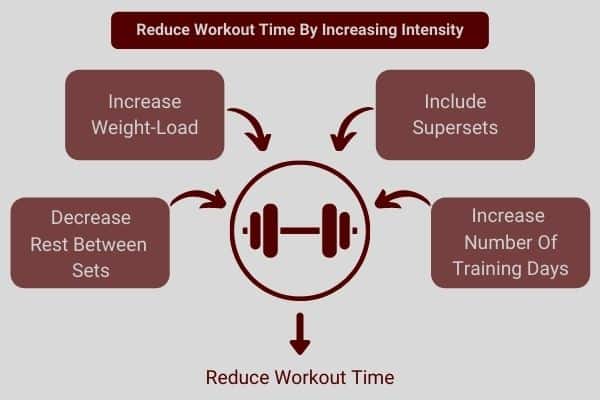
Hitting your training volume is an important concept to understand.
To put it simply- as long as you reach the required training volume to build muscle, your workout duration becomes less important.
The importance of training volume has been shown in this 2018 study.
Here, 34 men performed 13-minute squat workouts for 3 days per week. Additionally, they were assigned into 3 groups:
- Group 1 performed 1 set of squats in 13 minutes (low training volume).
- Group 2 performed 3 sets of squat in 13 minutes (medium training volume).
- Group 3 performed 5 sets of squats in 13 minutes (high training volume).
After 8 weeks, group 3 had overall thicker quadriceps, compared to the other groups.
This proves the point that satisfying the required training volume is what’s important, not training duration.
To put it simply-short but intense dumbbell workouts can build as much muscle as long low-intensity workouts!
Here are 4 ways to intensify a dumbbell workout:
- Use heavy weights- lift 70 to 90% of your maximum lifting capacity (1-rep max) for each exercise.
- Do compound lifts- big lifts activate more muscles in a single movement.
- Increase time under tension- lift slow and controlled to maximize muscle tension.
- Supersets- perform back-to-back sets targeting different muscle groups without rest in between.
- Decrease rest between sets- allows you to pack more sets into a short duration.
Read my other article to find out how much weight to lift to build muscle!
Signs Of A Good Dumbbell Workout.
So how do you know if you are pushing yourself hard enough when lifting dumbbells?
There are multiple ways to identify an effective dumbbell workout. Quantitative indicators include achieving your weekly training volume, being able to lift progressively heavier weights, and reaching 12 to 17 on the Borg scale. Qualitative indicators include an increased mood, appetite, and muscle tension.
The easiest way to identify good dumbbell workouts is to use the Borg scale of perceived exertion.
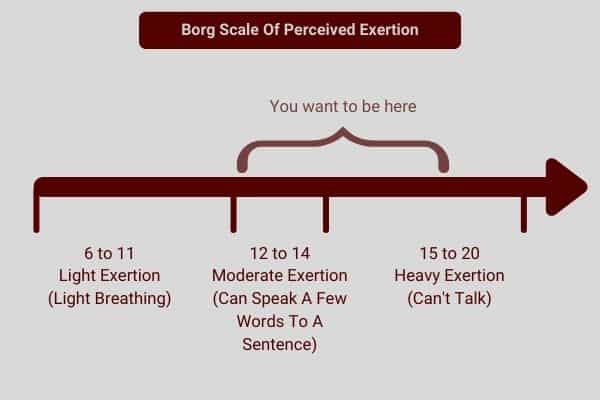
The scale is ranked from 6 to 20.
6 to 11 is defined as “light exertion”. You feel your muscles begin to fatigue, but your breathing remains light.
12 to 14 is defined as “moderate exertion”. You’re breathing becomes harder, and you can speak a few words to a sentence.
15 to 20 is defined as “heavy exertion”. You’re breathing is heavy and you struggle to talk.
You should aim to be between 12 to 17!
Other signs of a good dumbbell workout include:
- Training volume satisfied- you have completed all your sets and reps at the intended weights.
- Weight load is increasing- you’re lifting progressively heavier dumbbells compared to previous weeks.
- Energetic mood- you have that endorphin rush!
- Increased appetite- you’re hunger levels increase for extended periods post-workout.
- Muscles feel pumped- you feel your target muscles tense up (in a good way).
Is Lifting Dumbbells For 2+ Hours Too Much?
Many people lift weights for well over 1 and a half hours.
In fact, 35% of people lift weights for up to 2 or more hours (see poll).
So when does it become excessive? Can weight training for over 2 hours be too much?
In general, weight training for over 2 hours per workout is excessive. The required training volume for muscle growth in the average beginner to intermediate-level trainee can be achieved in 60 to 75 minutes of intense weight lifting. Therefore you should try to keep your workouts under 2 hours.
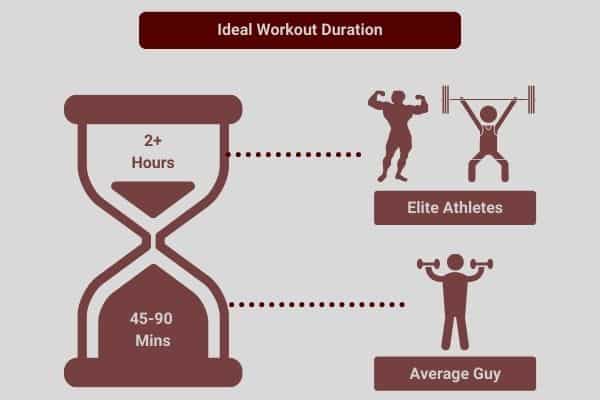
The exception for training over 2 hours per workout would be for highly trained weightlifters and bodybuilders. These guys have an extremely high muscle mass and are adapted to high volumes of training.
This is why they NEED to train for so long to maintain their mass and/or grow bigger.
You should also be cautious of the myth that the more you train, the bigger you will get.
Yes, it’s true that dumbbell training follows a dose-response relationship. In other words, the longer you lift, the more muscle you will gain.
But this is only true to a certain point.
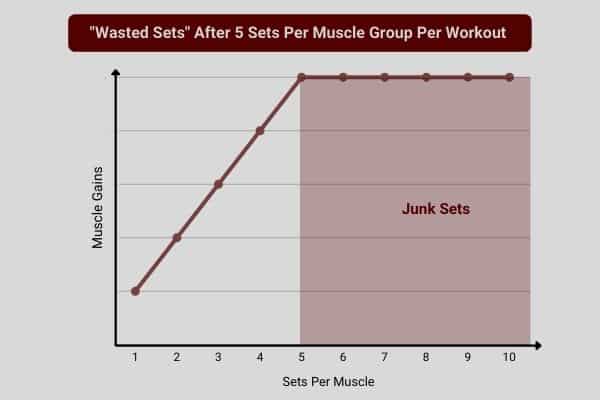
If you push past your optimum training volume, then your training becomes what’s called “junk volume“.
The concept of junk volume has been proven in this 2018 study.
Here, the scientists found that after 5 sets per muscle group, the muscle stops responding to growth stimulus.
To put it simply- hitting each muscle with more than 5 intense dumbbell sets per workout is a waste of time!
Instances Where A Dumbbell Workout May Take Longer.
5% of people state that they work out for as long as is required. And in my opinion, these are the smart guys.
As I discussed previously, you should take as long as it’s required to complete your training volume.
Usually, this takes between 60 to 75 minutes.
But sometimes it may take you longer to complete all your sets:
- Gym queues- lots of people using the same dumbbells as you will prolong your workout.
- Unilateral dumbbell exercises- such as the single-arm dumbbell row or dumbbell tricep kickback work one side of your body at a time and will extend your workout.
- Small dumbbell exercises- such as bicep curls are less intense than big exercises such as squats, so you can work out longer using these exercises.
- Training at a low intensity- lifting dumbbells below 70% intensity will permit you to train for longer.
These are all uncontrollable and reasonable factors to lifting dumbbells for more than 2 hours per workout.
Controllable factors include excessive socializing, resting too much, and scrolling social media. These activities will also prolong your workout!
Check out my other article for home gym ideas with dumbbells!
Signs You Are Lifting Dumbbells For Too Long.
So what are the signs that you’re lifting dumbbells longer than you should?
- Mental drive diminishes- your motivation falls significantly, compared to the beginning of your workout.
- Bad form- you’re swinging your body to help you lift dumbbells you had no problem with at the start of the workout.
- Incomplete sets- you aren’t completing all the reps in a set.
- Excessive resting times- you need to rest longer in between sets, compared to at the start of the workout.
These are all signs that you have been lifting dumbbells for too long.
Solution?
Identify and eliminate unnecessary exercises/sets in your next dumbbell workout!
A 75 Minute Full-Body Dumbbell Workout Plan For Beginners.
To wrap things up, here is a 75-minute full-body dumbbell workout you can try:
| Muscle Group | Dumbbell Exercises | Sets | Reps | Weight | Rest Between Sets |
|---|---|---|---|---|---|
| Chest | 1. Bench press 2. Incline bench press 3. Floor press. 4. Chest fly 5. Dumbbell pullover | 4. | 8. (14 for chest fly) | 80% of 1 rep max. (60% for chest fly) | 2 minutes |
| Shoulders | 1. Shoulder press 2. Hammer press 3. Front raise 4. Lateral raise 5. High pull | 4 | 8 (14 for front and lateral raise) | 80% of 1 rep max (60% for front and lateral raise) | 2 minutes |
| Arms | 1. Bicep curl 2. Reverse curl 3. Hammer curl 4. Tricep extension 5. Tricep kickback | 4 | 14 | 60% of 1 rep max | 2 minutes |
| Abs | 1. Weighted crunch 2. Side-bend 3. Kneeling woodchopper 4. Russian twist 5. Leg raise | 4 | 14 | 60% of 1 rep max | 2 minutes |
| Back | 1. Bent-over row 2. Single-arm row 3. Reverse fly 4. Shrugs 5. T-bar row | 4 | 8 (14 for reverse fly and shrugs) | 80% of 1 rep max (60% for reverse fly and shrugs) | 2 minutes |
| Legs | 1. Goblet squat 2. Lunge 3. Deadlift 4. Ham curl 5. Calf-raise | 4 | 8 (14 for ham curl and calf-raise) | 80% of 1 rep max (60% for ham curl and calf-raise) | 2 minutes |
You should choose 1 exercise from each muscle group for a single workout.
In other words, you will be performing 6 dumbbell exercises per workout, each targeting a different muscle group.
Then choose different exercises for the following week.
Regarding the number of workout days- start with 3 days per week. And as your body adapts, and you recover more quickly, you can increase to 4, then 5.
Also, don’t forget to increase the weight when you feel ready to do so. This is how you will continue building muscle!
Go to my other article for detailed information on how to perform these dumbbell exercises.
Conclusion
Today, I’ve revealed how long you should lift dumbbells if you want to gain muscle.
A full-body dumbbell workout should take around 60 minutes to complete, and no longer than 75 minutes.
This time can be extended in situations where you’re waiting for equipment, training at a low intensity, or performing exercises targeting the smaller muscles such as the biceps.
If you prefer short workouts, you can also reduce the time to around 20 to 30 minutes. However, you need to ensure that the required training volume is achieved. This can be achieved by increasing the intensity of your dumbbell exercises.
How long do YOU currently do dumbbells for?
Let me know in the comments below!
Alternatively, download the FREE Kalibre Muscle Blueprint to find out EXACTLY how I transformed my skinny body as a hardgainer!
Thanks for reading guys!
Peace Out,
Kal
(Biochemistry BSc, Biomedical Sciences MSc, Ex-Skinny Guy)


